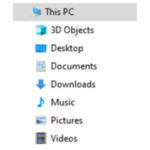
Windows has a sort of handy feature, but nobody has ever found it. Well, yeah, this one is ubiquitous. The “libraries.” Simple enough, a link to default folders for documents, pictures, etc. The helpful little feature is designed to minimize the amount of navigation required to open and/or save different types of files in easy to find, and organized places. It can also make backing things up easier. It also has a bit of an Achilles Heel side. It only takes one strategically placed sector to go bad and the computer won’t boot, and your libraries are inaccessible. I call it data roulette.  The user directory is where all of the eggs are placed in one basket. If you can’t access the user directory, then you can’t access anything in the default library locations.
The user directory is where all of the eggs are placed in one basket. If you can’t access the user directory, then you can’t access anything in the default library locations.
Before I go any further, let me make it clear that I am not saying that you shouldn’t use the default libraries. I’m sharing an experience I encountered that made me happy that I was not using them. I never bought into default library locations for two reasons. First, I was used to choosing where I want to put directories for my files. Secondly, if Microsoft wants you to do something, it is of dubious value, IMHO. For example, Bing is so bad that Microsoft has to bake it in to both the Windows and Edge to get people to use it. And so, without further ado, just sit right back and you’ll hear a tale, a tale of a fateful sector.
My laptop was having increasingly frequent problems booting. One day it would no longer boot. The cause of the problem was a bad sector located at the root of the user directory. This means that absolutely nothing under the user directory, including documents, picture, NSFW pictures, videos, NSFW videos, etc., were accessible, or in layman’s terms, “Oh crap.” This shouldn’t be enough to cause anything more than data loss in those directories, but it does get better. Microsoft and computer manufacturers integrate the OS with the BIOS such that when that specific sector goes, there’s no booting. In fact, taking the drive out and connecting it as external storage to another Windows computer wreaks havoc on that system too. In layman’s terms, WTF?
All was not lost though, I had a plan B. Sometime around 1995 I worked at Microsoft. One day helpdesk put out an appeal for assistance in recovering data from a computer that wouldn’t boot due to malware. I fixed the problem by using Slackware Linux boot and root floppy disks to fix the partition table. After the second time helpdesk ran into the problem, I was asked to teach them how to use Linux to repair Windows. Man, I love saying that. And so, I asked myself “What would Spock do? The logical thing to do was to boot from a live Ubuntu thumb drive. Presto! The laptop booted and I could access all of my data, except what was in the user directories. But, and this is a big but (disambiguation butt), I did not and do not use the normal library locations. That means I could access all of the data I wanted to. I always partition my drive and store my documents and pictures, etc. in different folders on the secondary data partition, or in some cases, on a different physical drive. I even use a different folder than the default for my Outlook PSTs.
In no time I was able to copy my data from the bad drive to an external drive. Unlike far too many of people, I did have a backup, but where’s the fun in that. Besides, backups don’t fix OS hosing hard drives.
I will be the first to tell you that the odds of that specific sector going bad are magnitudes less than the odds of an entire hard drive, or other sectors going bad. I would expect that a Windows bootable partition is far more likely to get corrupted than a secondary partition, a different hard drive, or even a politician. That is another argument for not using default libraries, or keeping the data on the windows partition.
 I understand that the libraries are quite convenient, but you don’t have to give up that convenience. The various folders that the libraries link to can be located wherever you like. You can change the location where the library files are located. Simply right-click on the library, bring up properties, go to the location tab, and choose the folder you want the files to reside in. For extra April Fool’s Day fun, swap the document and pictures folder locations on your kid’s computer! Bear in mind that your kid probably knows more about computers than you do, so be ready to blame a Microsoft update when they find the cause of the issue. Payback’s a bitch. You’ve been warned.
I understand that the libraries are quite convenient, but you don’t have to give up that convenience. The various folders that the libraries link to can be located wherever you like. You can change the location where the library files are located. Simply right-click on the library, bring up properties, go to the location tab, and choose the folder you want the files to reside in. For extra April Fool’s Day fun, swap the document and pictures folder locations on your kid’s computer! Bear in mind that your kid probably knows more about computers than you do, so be ready to blame a Microsoft update when they find the cause of the issue. Payback’s a bitch. You’ve been warned.
I’m not going to tell you that you are in grave danger if you use default locations; you aren’t. But you might want to consider alternative locations for your library type files, regardless of whether or not you redirect the library links.
Do maintain backups, and periodically verify that your backups are working. Linux was my plan C. Local backups are plan A, and cloud backups are plan B.
Randy Abrams
Senior Security Analyst and pseudo help desk specialist
SecureIQLab



